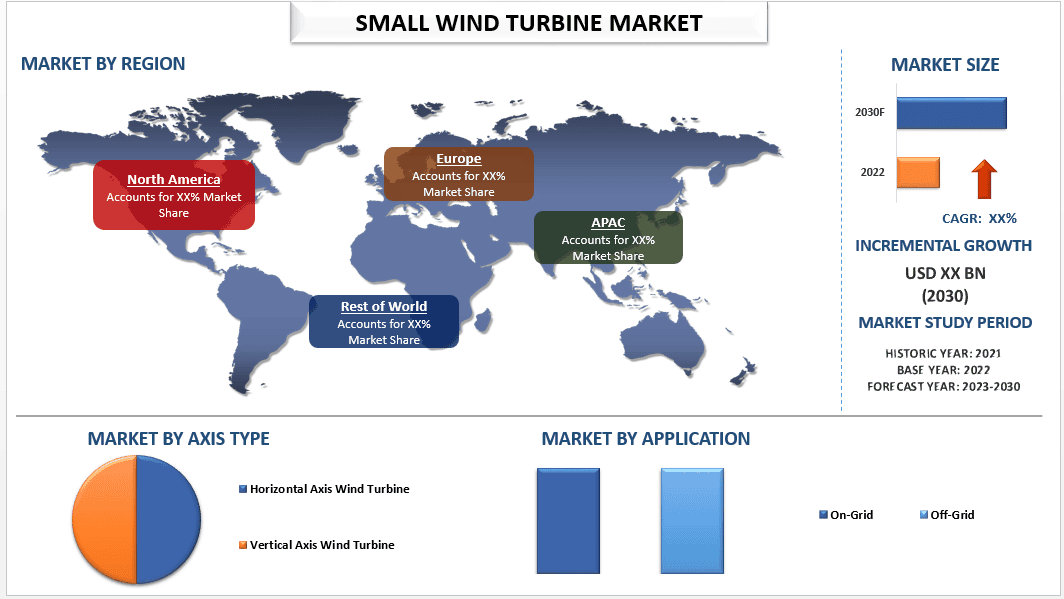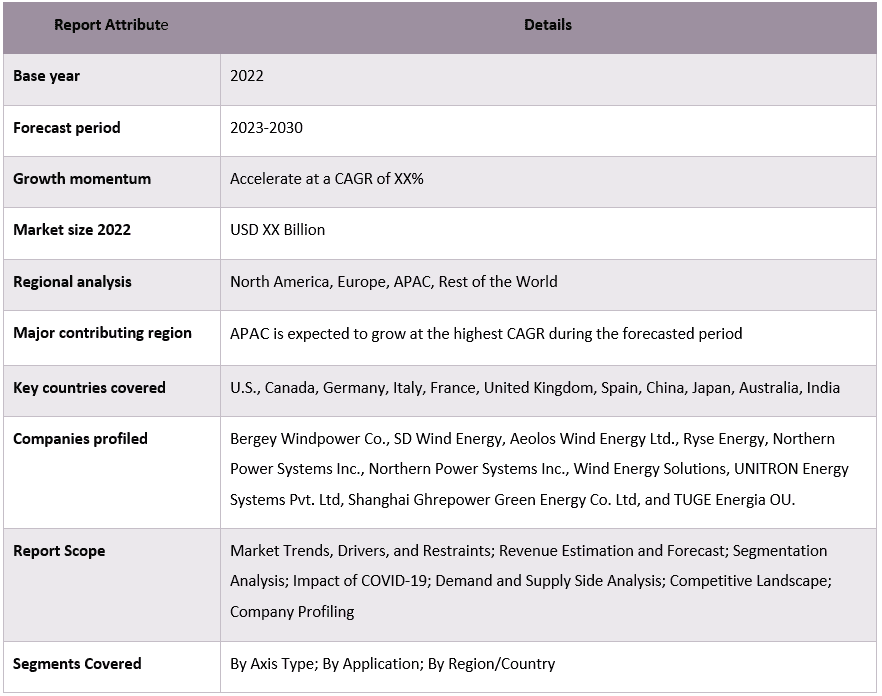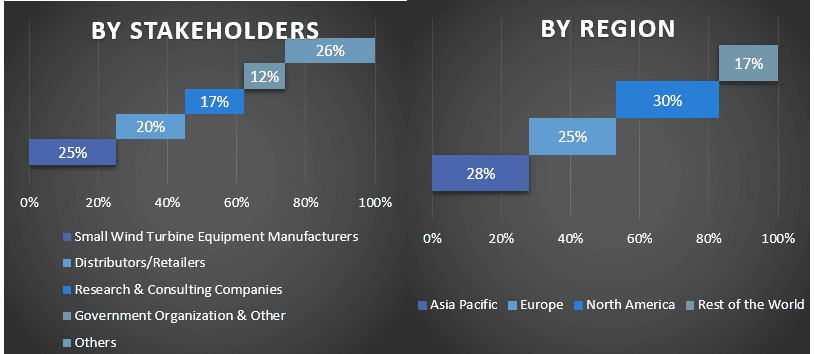Small Wind Turbine Market: Current Analysis and Forecast (2023-2030)
Emphasis on Axis Type (Horizontal Axis, and Vertical Axis Wind Turbine); Application (On-Grid, and Off-Grid); and Region/Country

The Small Wind Turbine Market is expected to grow at a strong CAGR during the forecast period(2023-2030). It is mainly owing to the government programs and incentives to promote cleaner renewable energy and increasing consumer awareness towards cleaner energy globally. Small wind electric systems can lower electricity bills by 50%–90%. It is typically deployed in rural areas as it provides electricity and avoids the high costs of having utility power lines extended to a remote location. Small wind electric systems can also be used for a variety of other applications, including water pumping on farms and ranches.
The majority of small wind turbines manufactured today are horizontal-axis, upwind machines with two or three blades. These blades are typically made of composite materials, such as fiberglass. Various nations are promoting renewable energy and have introduced subsidies, programmes, initiatives, and favorable policies in order to increase clean energy. The shift towards renewable energy from conventional energy is acting as a catalyst in the growth of the small wind turbine market during the forecast period. For instance – In December 2022, The National Renewable Energy Laboratory through the U.S. Department of Energy’s Competitiveness Improvement Project (CIP) announced plans to award $2.9 million to 11 manufacturers of small- and medium-scale wind turbine technology through CIP. These awards are given to manufacturers of wind turbines less than 1 megawatt in capacity. Bergey Windpower Company was one of the key companies nominated for this project.
Some of the major players operating in the market are Bergey Windpower Co., SD Wind Energy, Aeolos Wind Energy Ltd., Ryse Energy, Northern Power Systems Inc., Northern Power Systems Inc., Wind Energy Solutions, UNITRON Energy Systems Pvt. Ltd, Shanghai Ghrepower Green Energy Co. Ltd, and TUGE Energia OU.
Several M&As along with partnerships have been undertaken by these players to facilitate customers with hi-tech and innovative products/technologies.
Insights Presented in the Report
“Amongst Axis Type, the Horizontal Axis Wind Turbine segment held a dominating share of the market in 2022”
Based on Axis Type, The Small Wind Turbine market is divided into Horizontal Axis and Vertical Axis Wind Turbine segments. The Horizontal Axis Wind Turbine segment acquired a majority share in the Small Wind Turbine market and is expected to showcase a substantial growth rate during the forecast period. In a Horizontal Axis Wind Turbine, the main rotor shaft and generator are located at the top of a tower and can be directed into or away from the prevailing wind by a simple wind vane. While most small vertical axis wind turbines have been built in the last decade, the horizontal axis wind turbine has been in production for over 30 years. Small-scale horizontal axis turbines are gaining momentum due to the associated techno-economic advantages. Small horizontal axis wind turbines with high wind speeds enable wind power generation at low cost, do not require skilled labor and are easy to maintain. The vertical axis wind turbine is growing majorly due to the residential sector as they are the main deployment region of these turbines.
“Amongst Application, the Off-Grid segment held a dominating share of the market in 2022”
Based on Application, the Small Wind Turbine market is segmented into On-Grid and Off-Grid segments. The Off-Grid segment acquired a majority share in the Small Wind Turbine market and is expected to showcase a substantial growth rate during the forecast period. Off-grid small wind energy plays an important role in remote areas of underdeveloped and developing countries. Off-grid applications include rural residential electrification, telecommunication stations, offshore power generation, etc. These small wind turbines for off-grid applications can be connected to batteries for energy storage. As the cost of energy storage batteries has dropped in recent years, small wind power systems and storage batteries have become more economically viable for use in off-grid communities. These wind turbines are suited for areas where the transmission and distribution infrastructure is aging and areas with harsh weather conditions that are prone to power shortages.
Small Wind Turbine Market Report Coverage

“APAC dominated the Small Wind Turbine market in 2022”
APAC registered the highest market share in the Small Wind Turbine market and is expected to witness an influential CAGR in the forecasted period. It is mainly owing to many Small Wind Turbine projects taking place in China, India, Australia, South Korea, and Japan. Moreover, favorable government policies, regulations, and investments in achieving renewable energy targets set by various countries are driving the market. China has become a major player in the Small Wind Turbine market due to massive investments from the State Grid in the North and China Southern Power Grid in the South. The Chinese government has set targets for the share of non-hydro renewables of up to 25.9% in 2030 and 36.0% in 2035, expanding its total installed capacity of wind and solar power to over 1 200 GW by 2030. Subsidies and incentives promoting wind energy will act as a catalyst in the growth of the APAC Small Wind Turbine Market during the forecast period.
Reasons to buy this report:
- The study includes market sizing and forecasting analysis validated by authenticated key industry experts.
- The report presents a quick review of overall industry performance at one glance.
- The report covers an in-depth analysis of prominent industry peers with a primary focus on key business financials, product portfolios, expansion strategies, and recent developments.
- Detailed examination of drivers, restraints, key trends, and opportunities prevailing in the industry.
- The study comprehensively covers the market across different segments.
- Deep dive regional level analysis of the industry.
Customization Options:
The global Small Wind Turbine market can further be customized as per the requirement or any other market segment. Besides this, UMI understands that you may have your own business needs, hence feel free to connect with us to get a report that completely suits your requirements.
Table of Contents
Research Methodology for the Small Wind Turbine Market Analysis (2023-2030)
Analyzing the historical market, estimating the current market, and forecasting the future market of the global Small Wind Turbine market were the three major steps undertaken to create and analyze the adoption of Small Wind Turbine in major regions globally. Exhaustive secondary research was conducted to collect the historical market numbers and estimate the current market size. Secondly, to validate these insights, numerous findings and assumptions were taken into consideration. Moreover, exhaustive primary interviews were also conducted, with industry experts across the value chain of the global Small Wind Turbine market. Post assumption and validation of market numbers through primary interviews, we employed a top-down/bottom-up approach to forecasting the complete market size. Thereafter, market breakdown and data triangulation methods were adopted to estimate and analyze the market size of segments and sub-segments of the industry pertains to. Detailed methodology is explained below:
Analysis of Historical Market Size
Step 1: In-Depth Study of Secondary Sources:
Detail secondary study was conducted to obtain the historical market size of the Small Wind Turbine market through company internal sources such as annual reports & financial statements, performance presentations, press releases, etc., and external sources including journals, news & articles, government publications, competitor publications, sector reports, third-party database, and other credible publications.
Step 2: Market Segmentation:
After obtaining the historical market size of the Small Wind Turbine market, we conducted a detailed secondary analysis to gather historical market insights and share for different segments & sub-segments for major regions. Major segments are included in the report as Axis Type and Application. Further country-level analyses were conducted to evaluate the overall adoption of testing models in that region.
Step 3: Factor Analysis:
After acquiring the historical market size of different segments and sub-segments, we conducted a detailed factor analysis to estimate the current market size of the Small Wind Turbine market. Further, we conducted factor analysis using dependent and independent variables such as Axis Type and Application of the Small Wind Turbine market. A thorough analysis was conducted for demand and supply-side scenarios considering top partnerships, mergers and acquisitions, business expansion, and product launches in the Small Wind Turbine market sector across the globe.
Current Market Size Estimate & Forecast
Current Market Sizing: Based on actionable insights from the above 3 steps, we arrived at the current market size, key players in the global Small Wind Turbine market, and market shares of the segments. All the required percentage shares split, and market breakdowns were determined using the above-mentioned secondary approach and were verified through primary interviews.
Estimation & Forecasting: For market estimation and forecast, weights were assigned to different factors including drivers & trends, restraints, and opportunities available for the stakeholders. After analyzing these factors, relevant forecasting techniques i.e., the top-down/bottom-up approach were applied to arrive at the market forecast for 2030 for different segments and sub-segments across the major markets globally. The research methodology adopted to estimate the market size encompasses:
- The industry’s market size, in terms of revenue (USD) and the adoption rate of the Small Wind Turbine market across the major markets domestically
- All percentage shares, splits, and breakdowns of market segments and sub-segments
- Key players in the global Small Wind Turbine market in terms of technology offered. Also, the growth strategies adopted by these players to compete in the fast-growing market
Market Size and Share Validation
Primary Research: In-depth interviews were conducted with the Key Opinion Leaders (KOLs) including Top Level Executives (CXO/VPs, Sales Head, Marketing Head, Operational Head, Regional Head, Country Head, etc.) across major regions. Primary research findings were then summarized, and statistical analysis was performed to prove the stated hypothesis. Inputs from primary research were consolidated with secondary findings, hence turning information into actionable insights.
Split of Primary Participants in Different Regions

Market Engineering
The data triangulation technique was employed to complete the overall market estimation and to arrive at precise statistical numbers for each segment and sub-segment of the global Small Wind Turbine market. data was split into several segments & sub-segments post studying various parameters and trends in the areas of Axis Type and Application in the global Small Wind Turbine market.
The main objective of the Global Small Wind Turbine Market Study
The current & future market trends of the global Small Wind Turbine market were pinpointed in the study. Investors can gain strategic insights to base their discretion for investments on the qualitative and quantitative analysis performed in the study. Current and future market trends determined the overall attractiveness of the market at a regional level, providing a platform for the industrial participant to exploit the untapped market to benefit from a first-mover advantage. Other quantitative goals of the studies include:
- Analyze the current and forecast market size of the Small Wind Turbine market in terms of value (USD). Also, analyze the current and forecast market size of different segments and sub-segments
- Segments in the study include areas of Axis Type and Application.
- Define and analysis of the regulatory framework for the Small Wind Turbine industry
- Analyze the value chain involved with the presence of various intermediaries, along with analyzing customer and competitor behaviors of the industry
- Analyze the current and forecast market size of the Small Wind Turbine market for the major regions
- Major countries of regions studied in the report include Asia Pacific, Europe, North America, and the Rest of the World
- Company profiles of the Small Wind Turbine market and the growth strategies adopted by the market players to sustain in the fast-growing market
- Deep dive regional level analysis of the industry
Related Reports
Customers who bought this item also bought










